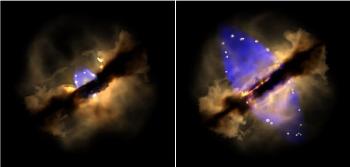Apr 10 2015
An international team of astronomers, in which some UB researchers collaborate, has first observed the moment in which a massive protostar begins to develop jets of matter and energy, crucial for star formation.
 First, the massive protostar W75N(B)-VLA 2 ejects matter in in all directions. Jet turns into collimated when it expands in toroidal gas and dust environment. Image: Wolfgang Steffen (UNAM)
First, the massive protostar W75N(B)-VLA 2 ejects matter in in all directions. Jet turns into collimated when it expands in toroidal gas and dust environment. Image: Wolfgang Steffen (UNAM)
The study, led by Carlos Carrasco-González (UNAM, México) and recently published in the journal Science, has been developed by researchers from the Institute of Cosmos Sciences of the UB (ICCUB-IEEC), the Institute of Space Sciences (CSIC-IEEC) and the Institute of Astrophysics of Andalusia (IAA-CSIC).
Stars are formed inside relatively dense concentrations of interstellar gas and dust, known as molecular clouds. When denser parts of the cloud core collapse under their own weight/gravity, stars are formed. Accretion of material onto the embryo star continues partially from the newly formed circumstellar disc. In this stage, bipolar jets are produced, which are the means by which infalling material is expelled.
The phenomenon of collimated outflows happens in diverse astronomical objects, for example young stars, black holes in galactic nuclei, and stars at the end of their life cycles. However, how collimated outflows begin and what factors regulate their degree of collimation remain unknown.
The study proves that the massive protostar W75N(B)-VLA2 has dramatically changed the way in which it expels matter. It has allowed observing the transition from the first regime in which the star ejects matter in all directions, and a second regime in which the ejection is along a preferred single direction, forming the jet. Although star formation processes trigger hundreds of thousands of years, researchers have been able to observe how the wind from the protostar has evolved from a compact to an elongated source in only 18 years, from 1996 to 2014.
Guillem Anglada, researcher at IAA-CSIC who participates in the study, explains that “current theories state that young stars expel matter in collimated outflows. However, previous studies showed that some young massive stars go through episodic, short-lived events in which the material is expelled in all directions”. Therefore, experts thought that the transition from an uncollimated outflow to a collimated outflow takes place at a certain moment. “This transition is exactly what we are observing in W75N(B)-VLA2”, highlights Anglada.
Data supports the current paradigm of star formation through accretion disks. “The study opens a new exciting window of opportunity to study how the basic ingredients of star formation evolve over the next few years. We are lucky to be on the brink of describing and modelling in “real time” all of these rapid changes”, concludes José María Torrelles, researcher at ICE-CSIC/ICCUB who collaborates in the study.